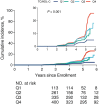Association of total cholesterol to high-density lipoprotein cholesterol ratio with diabetes risk: a retrospective study of Chinese individuals
- PMID: 40346160
- PMCID: PMC12064768
- DOI: 10.1038/s41598-025-87277-0
Association of total cholesterol to high-density lipoprotein cholesterol ratio with diabetes risk: a retrospective study of Chinese individuals
Abstract
A common complication of type 2 diabetes is hypercholesterolemia in many patients. It is still unclear, nevertheless, how high-density lipoprotein cholesterol ratio (TC/HDL-C), total cholesterol, and diabetes are related. The purpose of this study is to look at the prediction ability and causal relationship between TC/HDL-C and diabetes. This study included 117,268 subjects who were undergoing physical examinations. The subjects were grouped into four equal groups according to the TC/HDL-C quartiles; the main outcome was the occurrence of diabetes events. TC/HDL-C is calculated as total cholesterol divided by high-density lipoprotein cholesterol. In 3.1 years (± 0.95) of follow-up, 795 women (0.68%) and 1,894 men (1.62%) received new diabetes diagnoses. TC/HDL-C is an independent predictor of new-onset diabetes, according to multivariable Cox regression analysis (HR 1.27 per SD increase, 95% CI: 1.09-1.48, P for trend < 0.001). It turned out that a cutoff value of 3.55 (area under the curve 0.64, sensitivity 0.66, specificity 0.56), was ideal for TC/HDL-C in predicting new-onset diabetes. A subgroup analysis demonstrated that the younger population had a significantly higher risk of TC/HDL-C-related diabetes than the middle-aged group (interaction P < 0.05). After controlling for confounding variables, this Chinese cohort study reveals a direct correlation between TC/HDL-C and diabetes, with a stronger independent association observed in younger and middle-aged individuals.
Keywords: Cohort study; Diabetes; Risk factor; TC/HDL-C; Total cholesterol: high-density lipoprotein cholesterol ratio.
© 2025. The Author(s).
Conflict of interest statement
Competing interests: The authors declare no competing interests. Ethics approval and consent to participate: Due to the retrospective nature of the study, the need of obtaining approval was waived. Informed consent: Due to the retrospective nature of the study, (Institutional Review Board) waived the need of obtaining informed consent.
Figures



Similar articles
-
The Association Between the Triglyceride to High-Density Lipoprotein Cholesterol Ratio and the Incidence of Type 2 Diabetes Mellitus in the Japanese Population.Metab Syndr Relat Disord. 2024 Aug;22(6):471-478. doi: 10.1089/met.2023.0314. Epub 2024 Apr 8. Metab Syndr Relat Disord. 2024. PMID: 38593410
-
Triglyceride to high-density lipoprotein cholesterol ratio is associated with incident diabetes in men: A retrospective study of Chinese individuals.J Diabetes Investig. 2020 Jan;11(1):192-198. doi: 10.1111/jdi.13087. Epub 2019 Jul 1. J Diabetes Investig. 2020. PMID: 31145539 Free PMC article.
-
Lipid ratios and appropriate cut off values for prediction of diabetes: a cohort of Iranian men and women.Lipids Health Dis. 2010 Aug 17;9:85. doi: 10.1186/1476-511X-9-85. Lipids Health Dis. 2010. PMID: 20712907 Free PMC article.
-
The Non-High-Density Lipoprotein Cholesterol (Non-HDL-C) to HDL-C Ratio (NHHR) and Its Association with Chronic Kidney Disease in Chinese Adults with Type 2 Diabetes: A Preliminary Study.Nutrients. 2025 Mar 24;17(7):1125. doi: 10.3390/nu17071125. Nutrients. 2025. PMID: 40218883 Free PMC article.
-
The lipid triad in type 2 diabetes - prevalence and relevance of hypertriglyceridaemia/low high-density lipoprotein syndrome in type 2 diabetes.Exp Clin Endocrinol Diabetes. 2004 Feb;112(2):75-9. doi: 10.1055/s-2004-815753. Exp Clin Endocrinol Diabetes. 2004. PMID: 15031770 Review.
References
-
- Elsayed, N. A., Aleppo, G., Aroda, V. R., et al. Classification and diagnosis of diabetes: standards of care in diabetes-2023. Diabetes Care46(Suppl 1), S19–s40 (2023).
-
- Joslin, E. P. Diabetes mellitus. N. Engl. J. Med.234, 476 (1946). - PubMed
MeSH terms
Substances
Supplementary concepts
Grants and funding
LinkOut - more resources
Full Text Sources
Medical

